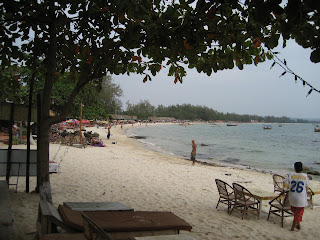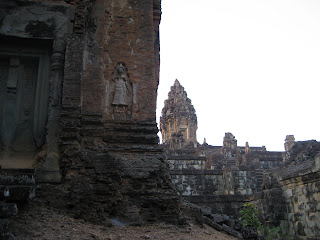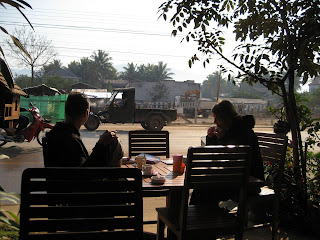About 15 miles north of Luang Prabang and about 30 miles west of Pak Xeng we started biking on the dirt road that runs parallel to the river. We passed many small villages located between the road and the river.

In the first village we visited was a black smith making knives for use in the jungle. The bellows used to make the fire very hot was made of a large bamboo tube.

We rode along the road for about 20 miles before stopping for the evening. After setting our bags down we went to the river for a cool dip.

When I came back, two of the girls in our group were playing cards with a few of the men (not for money, though). A big group of folks gathered around to watch and a good time was had by all. The Lao were talking up a storm and having great fun at our expense. They think our pointy noses are funny...
We sat down for dinner of sticky rice and duck and went to sleep by 8.
In the morning after a big breakfast and Nescafe, we crossed the river and started a long steep climb into the jungle. It seems they prefer the direct route in Laos. While it got hot quickly at least it wasn't wet, which would make the trails impossible. Sarah came down with heat stroke about half way to our destination in the mountains and eventually threw-up. But she kept going perhaps because there was not much of an alternative.

We hiked through forests of bamboo and teak. In the hills they grow dry rice (unlike near the river where much more productive paddies are used to grow wet rice. The farmers have begun burning the fields to clear them and kill-off the pests. In this heat and at the steep inclines there is no practical alternative. The dry rice fields are let fallow for several years as the land won't produce after the first year.
The villagers make there own gun powder for the small caliber flint lock guns they use to shoot birds. I saw them bounding charcoal in a mortice and then adding sulfur. Urea was in plentiful supply...
In many the villages the waste water and garbage run out of town in a mini-swamp thoroughly picked over by ducks, chickens, pigs and dogs (but not cats). Before the arrival of plastic bags this running compost heap would have looked natural, but it looks like a real dump know. I suspect the sight has become completely normalized. There are no latrines and no showers.
The villages are essentially barnyards that people live in. Dogs, chickens and ducks wander in and out of the houses looking for floor scraps. So the ground is picked clean by their combined work. They are not fed directly and they are not kept as pets though the dogs are sometimes used for hunting.
Not need to worry about ornery dogs or other animals, I think they were bred to keep their cool and thus avoid being next in line for dinner.

Lots and lots of children. They were all healthy and as far as I could tell, spent the whole day playing and laughing.

We had lunch in a hut in a Hmong village. FYI: they believe in spirits and are not Bhuddist as they are in LP and the rest of Laos.
When we showed up for our second evening in a village way up in the hills I was immediately invited in for drinks with several gentlemen who were traveling teachers for the local villages. The oldest, 61, a Mr Bouvien, spoke French so I could converse with him. We spoke in English, French and Lao.

They wanted to know if I was married, how much teachers make in the US, (they made between $300 and $600/year). However they did point out they had a house and all I had was an apartment. They did not understand the possibility of snow or a frozen river. After 7 shots of Lao Lao I called it quits and joined the others for dinner. Sticky rice, duck meat, cooked vegetables, chili paste and broth.
For entertainment we played riddles with a set of candles (example: moving only two candles get the ball to be outside of the box). With nothing else to occupy us we had a great time. Without a doubt the Lao spend a lot of time laughing and joking around.
They are subsistence farmers. When Laos turned communist in 1975, the government tried collectivizing farms but gave up in three years after they concluded it would not work.

They let the existing means of production revert back to the ways that had been in practice since god knows when.

However, the Lao government is moving the less accessible villages down to the river from the hills, presumably to allow greater access to education, goods and the rapidly modernizing economy. When they pave the dirt road, the traffic will increase substantially and among other things make playing in the road a lot less safe. Right now all that goes by are local traffic by small truck and a few mopeds
Today we hiked out and down to the river to complete the third leg of our trip: Kayaking. I swam across the river to cool off from the brutal hike down.

The river was low, so lots of class 1 stuff of now consequences. We stopped a beach for a swim. There were water buffalo crossing the river, fishermen running nets across the river.
When we walked from the river to the truck, several villagers were slaughtering a pig in common wash basin.
On the way back to LP we stopped to drop of the kayaks at the owners house. Next door there were about forty people having a barbeques and gambling on cock fights. Nice neighbors...



















































